Coco peat as nursing medium could just be a game changer in getting seeds (that must start at the nursery) to germinate faster.
Getting seeds to germinate faster is important to reaching an early harvest. Also, if you can germinate seeds faster within in a specified period, then you can rapidly germinate seeds uniformly. The result is that you not only reach an early harvest but also a uniform harvest.
Germinating seeds faster helps to expedite production phase and in effective planning and decision making and with efficient input use.
When crops undergo uniform growth and development, they can be collectively managed and given resources at the same time throughout their lifecycle, saving time and resources.
Having nursed tomato seeds with different growing mediums, I have observed that tomato seeds tend to germinate faster in coco peat than other mediums -manure rich soil, potting soil, etc.
I have often wondered why so and thus took to observation, investigation and reflection. And to this I have come up with an explanation which gives a possible answer.
Tomato seeds, naturally, come enclosed in a thin outer layer called seed coat (also known as testa). This coat serves to protect the seeds and keep them intact (when they are not/until ready) for germination.
Thus, germination begins when, among other factors constant, the seed coat is broken, allowing oxygen, water in to activate respiration and growth hormones (gibberellins and abscisic acid) respectively, and the radicle (embryonic root) and plumule (the shoot structure) grow out.
For tomato, seed coat breaking is often accelerated by soaking seeds in water before sowing in growing medium, to scar the seed cell wall by water action (oxidation) which enables water permeate the seed and in time become turgid, rupturing the outer cell wall.
This is done also, unknowingly, as a process, when the seeds are sown in growing medium and wetted. By this way, too, the seed still get soaked since the nursing medium holds water that would eventually soak the seed.
This same process occurs with using coco peat, but I would like to posit, with coco peat, some other factors –sustained oxidative reaction, heightened osmosis, density, water molecules pressure and gravity –cause seed coat to rupture and even faster than -but complement/is aided -by seed-soaking.
Density is the mass to volume ratio of an object. Object with more mass to volume ratio will be dense(r). A coin, for instance, has more mass to volume ratio and is dense.
The common way to know how dense an object is is to place it in water. When denser than water an object will sink to the bottom, put in a jar of water.
Objects, introduced in water, will then sink, submerge, partially submerge, or totally float, in their relative densities to that of water.
In a partially submerged state, an object has a mass (acted upon by gravity culminating into weight) able to displace a certain volume of water.
The downward force from the weight of the object displacing the water body creates an upward and opposite force, thrust, until it equals that exerted by the object, where then the object ceases to descend in the water but instead stabilizes and floats, partially submerged.
This depicts Archimedes Principle and exhibits floatation law. It is what we observe of ship when part of its bottom is under water and the rest (the greater part) of the body above.
Water in its pure form has a density of 1g/ml and is higher than that of tomato seed; hence, the latter would float on the former.
Evidently, there will not be force of densities difference (thrust) acting against tomato seed since it is not submerged in water as its mass is not significant enough to displace some portion of water to yield a counter force (see fig. 1).
However, the case is not the same when coco peat is introduced; but tomato seed in water alone would still undergo osmosis directing its in-taking of water to become soaked, and this process can be more intense in a growing medium of coco peat-water mix.
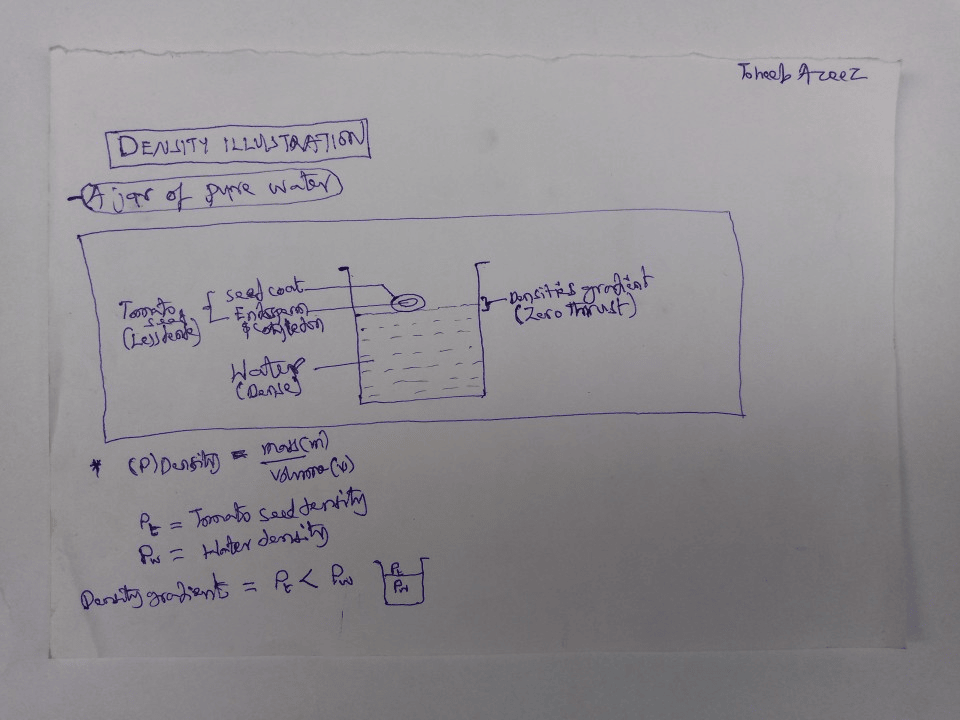
Sustained Oxidative Reaction:
While osmotic gradient would facilitate the movement of water molecules from pure water into tomato seed, its impervious seed coat will, however, deter the flow and the seed coat needs to be impaired to allow for osmosis.
Micropyle (small opening in seed) could aid water penetration, but when not effective/present then there would be a need to impair the seed coat one way or the other.
One way this can be done or is being done is through water action on the seed coat. Water has an oxidizing effect on seed coat, altering the nature of the hydrophobic lipid and protein structures that form its membrane (see fig. 2).
This creates crack on the seed coat that water can pass through. With this it enables osmosis.
The water action on the testa even becomes more potent when coco peat is used as nursing medium as it ensures (in its capability to hold and readily release good quantity of water to surrounding hydrophilic object) water is always around the seed coat.
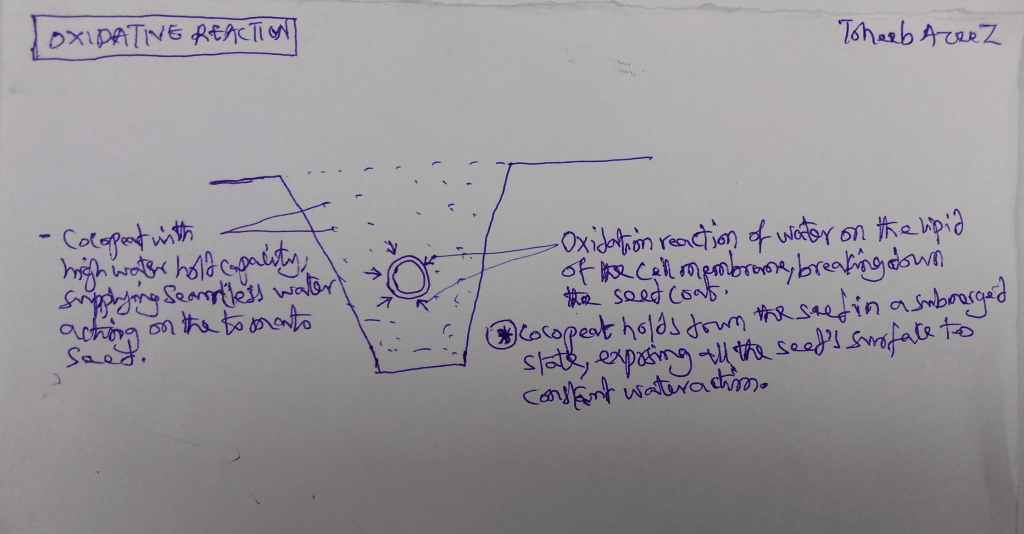
Heightened Osmosis:
Water movement inter-cells/media follows osmosis; it moves from a region of low concentration to a region of high concentration.
It is often advised not to swim for long in salty water, because –with the salt content –the water is more concentrated than our bodily fluid, thus, water will move from one’s body into the surrounding salty water, leaving one dehydrated.
The tomato seed has more osmotic potential than water, and on that basis, water would readily move into it.
But in an only-water medium, osmosis takes place in tomato seed slowly and gradually toward cell turgidity as the seed being less dense than water floats and has only one of its two broad sides touching water. This is different in a coco peat-water mix environment.
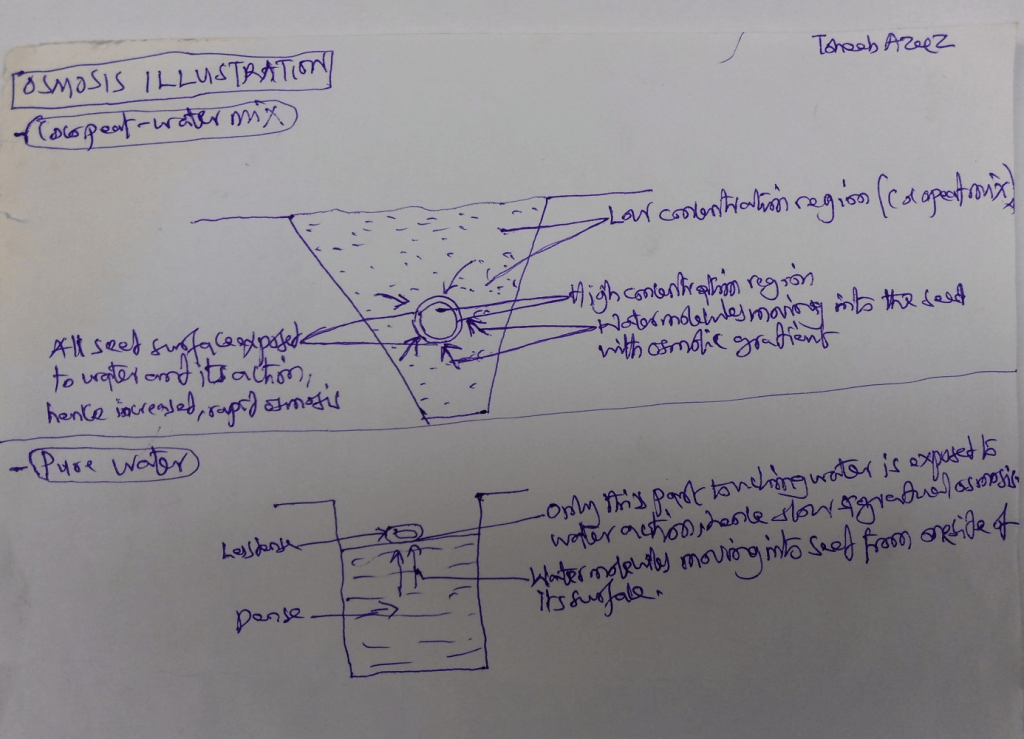
In the aforementioned growing medium, sowed into the coco peat mix and covered, the tomato seed has every of its sides exposed to water (action) (see fig. 3 for illustration).
Osmosis then happens through all surfaces of the seed and at constant rate with coco peat supplying seamless water, of its water-holding nature, where more water goes into the seed and making it rapidly turgid, pressuring the seed coat. Density intensifies this pressure.
Density:
Since the tomato seed is held in a submerged state in the coco peat-water mix instead of it floating as it should with its lesser density to water, the seed then come under intense pressure to float which does not happen as it is being held strongly by compactness of coco peat-water mix .
Rather, the part of it –the seed coat –which is not tightly held to the seed and that can peel off with pressure, gives way (consult fig. 4).
It is important to note that the tomato seed has two densities; one, less dense, for its core content (endosperm, cotyledon, embryo held within the inner membrane) and the other, least dense, for the outer wall (seed coat or testa).
It is logical that the least dense part would receive most thrust pressure as it is the part more ready to float and its flexible nature allows it to find its way through the coco peat mix pores to the top, when detached from the inner cell membrane.
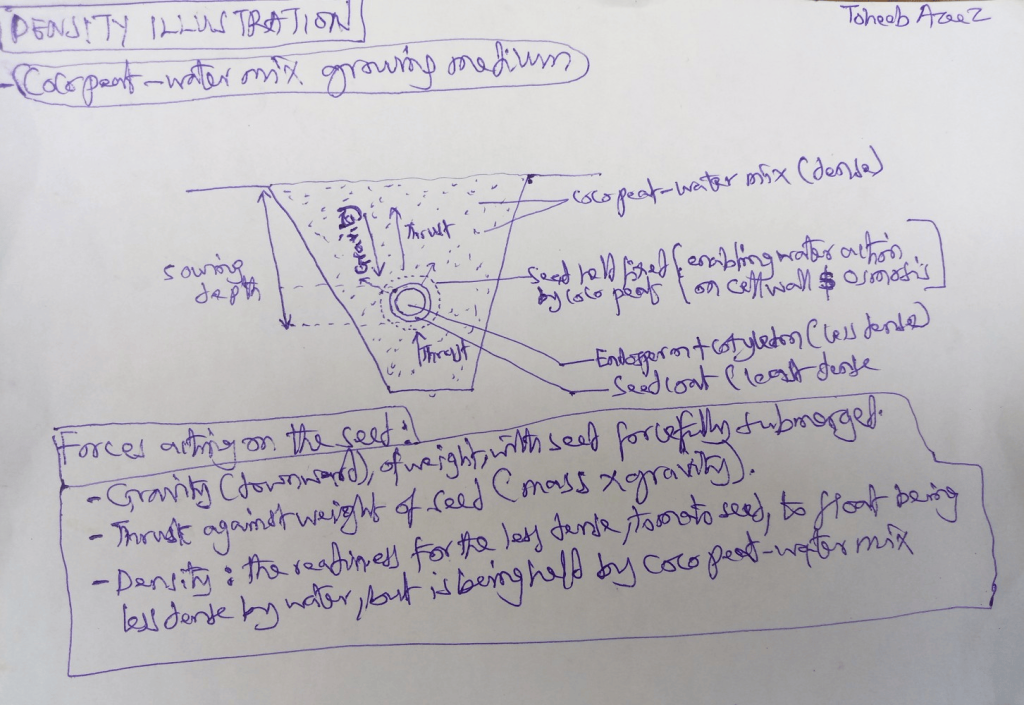
Density in action here is actually powerful. If you take time to sow tomato seed in coco peat-water mix, several hours from sowing you would actually see the testa of the seeds on the mix surface and the distinct vertical holes left behind by the testas from rising to the surface, telling of forceful ejection.
Interestingly, these vertical holes aid the easy emergence of the plumule since the plumule will just have to grow through the hole out to the top, unlike in typical soil medium where the plumule has to push its way through dirt to surface.
Additionally, aside density, increased osmosis and attending turgidity, water molecules pressure could have a role in rapid seed coat rupture. (I do not really think water molecule pressure could have much impact. Not that the event is not plausible, but that it might not really occur as to the environmental scenario it is borrowed which happens on a broader scale. Yet, I would give it a shot.)
Water molecules pressure:
It is a commonly held knowledge that the deeper the depth of an ocean, the higher the pressure. Pressure in deep waters is fatal to (non-adapted) animate beings and even some inanimate explorative tools.
The explanation is that water molecules at the bottom have immense pressure mounted on them by several water molecules above them and compounded by gravity (check fig. 5 for more depiction).
Imagine arranging 15 heavy textbooks on one another on a table. When you try to carry all the textbooks together at a go from the bottommost book closer to the table you would realize how heavy it is. But that is the pressure exerted by the 14 other textbooks on the first textbook on the table.
I like to imagine that water molecules above in coco peat-water mix exert pressure on tomato seed sowed to a particular depth in the growing medium.
However, I am not really content with this as, first, tomato seeds are not to be sowed too deep hence when done so germination is impacted; second, the impact of water molecules pressure might not be as significant or plausible as played out in the ocean.
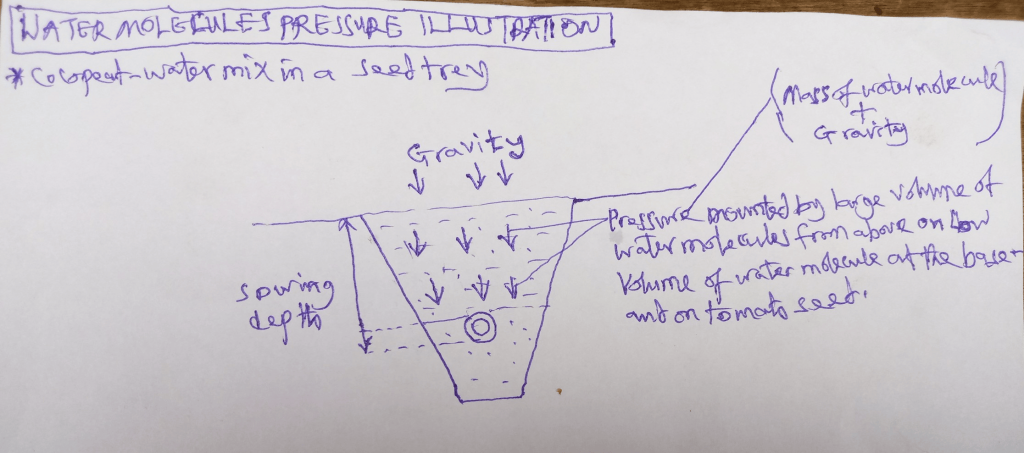
Afterthought:
Seed coat needs to break for germination to occur. Naturally -and with conventional sowing method -soaking ensures this happens. Left to natural or induced seed-scarring, seed coat will break, but gradually overtime.
Coco peat optimizing prevailing actions and forces (oxidation, turgidity, osmosis and attendant cell size increase from embryonic growth) that help to rupture seed coat and enabling other phenomena and actions (density, water molecules pressure, thrust, gravity) fast track the process.
While this informs the importance of coco peat as nursing medium than other media, (I think) it should rather spur thoughts on seizing and applying understandings from it to another medium.
Raising seeds for commercial scale farming would require using tones of coco peats. This in turn would drive emission of greenhouse gases, not directly from using coco peat but from working the earth planting numerous coconut trees to supply husk of coconut for coco peat making.
The tomato seeds rather, could be scarred (in multiples of batches), with water instead, utilizing hydrodynamics and hydrostatic attributes of water and mechanical properties of the seeds and with other forces and reactions as in play with coco peat.
But this would require balancing all the above characteristics, else too much pressure could rupture the seed or a mishap delay germination. Moreover, cell injury which can sometimes be irreparable do occur during imbibition and go on to affect plant throughout lifecycle.
